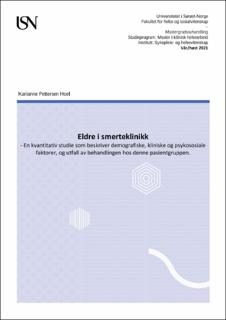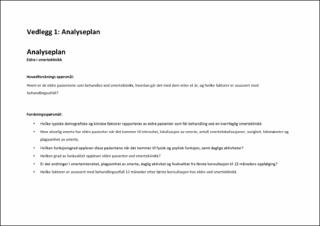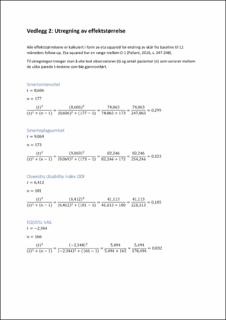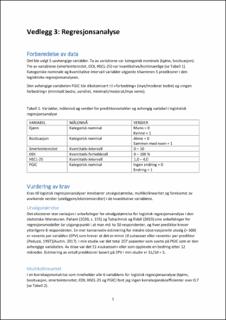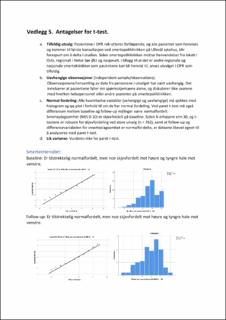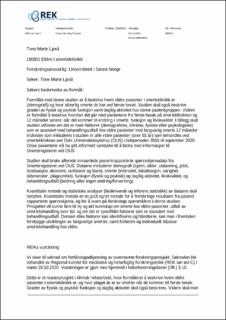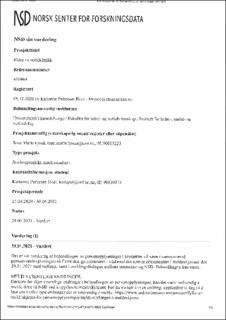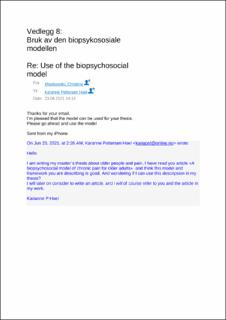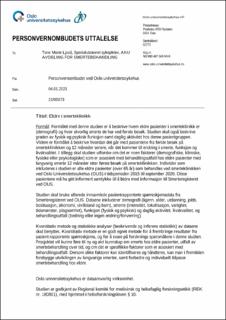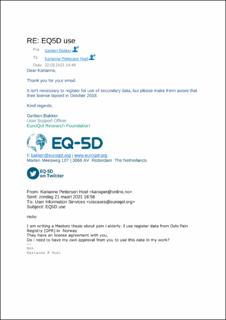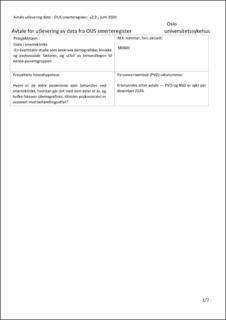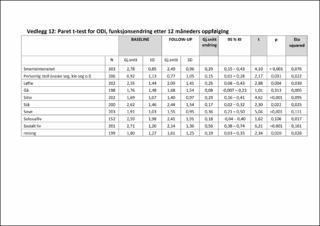| dc.contributor.advisor | Ljoså, Tone Marte | |
| dc.contributor.author | Hoel, Karianne Pettersen | |
| dc.date.accessioned | 2021-11-26T17:41:18Z | |
| dc.date.issued | 2021 | |
| dc.identifier | no.usn:wiseflow:6195646:45071035 | |
| dc.identifier.uri | https://hdl.handle.net/11250/2831746 | |
| dc.description.abstract | Sammendrag
Langvarige smerter blant eldre er en betydelig utfordring både for den enkelte pasient og for samfunnet. Formålet med studien er å fremskaffe ny og mer kunnskap om smerter hos eldre pasienter ved smerteklinikk, utfall av smertebehandling over tid, og om det er spesifikke faktorer som er assosiert med behandlingsutfall. Denne type kunnskap kan i fremtiden være med å forebygge utviklingen av langvarige smerter, samt forbedre og individuelt tilpasse smertebehandling hos eldre. Problemstillingen belyses ved hjelp av den biopsykososiale modellen.
Studien er en kvantitativ og longitudinell studie, som beskriver og utforsker registerdata fra OUS smerteregister (OSR). Det er gjort et utvalg av variabler fra OSR, for å belyse kliniske, fysiske, psykiske og sosiale faktorer hos de eldre pasientene, samt opplevd helserelatert livskvalitet. Det er benyttet statistiske analyser med beskrivende og infererende statistikk, for å belyse og se på forskjeller og sammenhenger i pasientgruppen eldre med langvarig smerte i smerteklinikk.
Resultatene fra studien viser til at den eldre pasienten i smerteklinikk i gjennomsnitt er 73 år, har god utdanning og økonomi. Smertene har vedvart i nesten 9 år før behandling ved smerteklinikk. Smerteintensiteten ligger på 7,43 (NRS), og smerteplagsomheten er 7,61 (NRS). Pasientene opplever at de ikke har en god helse, og neste 70 % har en moderat kroppslig stresstilstand. Den fysiske, psykiske og sosiale funksjonen oppleves som betydelig redusert for eldre pasienter med langvarig smerte, noe som kommer til utrykk ved at de oppgir sin generelle helsestatus til 44,02 (EQ-5D VAS). Regresjonsanalysen viser til tre prediktorer ved baseline (høyere smerteintensitet, bedre psykisk funksjon og bedre fysisk funksjon) for forbedring ved 12 måneders oppfølging hos den eldre pasientgruppen.
Konklusjon: Den eldre pasienten i smerteklinikk er resurssterke mennesker utfra sosioøkonomisk status. Disse pasientene oppgir en oppsiktsvekkende lav helserelatert livskvalitet sammenlignet med andre pasientgrupper med kroniske og sammensatte helsetilstander. Gjennom masterstudien kommer det frem at fysiske, psykiske og sosiale faktorer må bli utredet og behandlet også hos eldre pasienter. | |
| dc.description.abstract | Abstract
Chronic pain among the elderly is a significant challenge for both the individual patient and for society. The purpose of the study is to provide new and further knowledge about pain in the elderly patients at the pain clinic, the outcome of pain treatment over time, and whether there are specific factors which are associated with the outcome of treatment. This type of knowledge may in the future contribute in preventing the development of chronic pain, as well as improve and individually adapt pain treatment in the elderly. The biopsycososial model is used as to highlight the issue.
The study is a quantitative and longitudinal study, which explores registered data from OUS pain register (OSR). A selection of variables from OSR has been made, to illuminate clinical, physical, mental and social factors in the elderly patients, as well as the experienced health-related quality of life. It uses statistical analysis with descriptive and inference statistics, to illuminate and look at the differences and associations occurring the patient group of elderly with chronic pain in the pain clinic.
The results from the study indicate that the elderly patient in a pain clinic is an average of 73 years old, well educated, with no financial difficulties. The pain has persisted for almost 9 years before treatments at the pain clinic. The pain intensity 7,43 (NRS) and the pain severity 7,61 (NRS) is high. Patients experience that they do not generally have good health, and almost 70 % have a moderate state of physical stress. Physical, mental and social function is perceived as significantly reduced for elderly patients with chronic pain, which is expressed by stating their general health status to 44.02 (EQ-5D VAS). The regression analysis refers to three predictors at baseline (higher pain intensity, better mental function and better physical function) for improvement at 12 months follow-up with the elderly patient group.
Conclusion: The elderly patient in the pain clinic are resourceful people from a socio-economic point of view. These patients report a remarkably low health-related quality of life, compared with other patient groups with chronic and complex conditions. Through the masters study, it has been revealed that physical, mental and social factors must also be investigated and treated in elderly patients. | |
| dc.language | nob | |
| dc.publisher | University of South-Eastern Norway | |
| dc.title | Eldre i smerteklinikk - En kvantitativ studie som beskriver demografiske, kliniske og psykososiale faktorer, og utfall av behandlingen hos denne pasientgruppen | |
| dc.type | Master thesis | |
